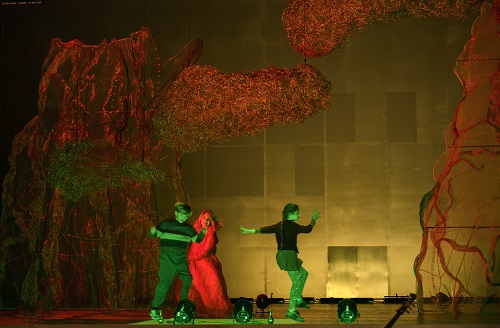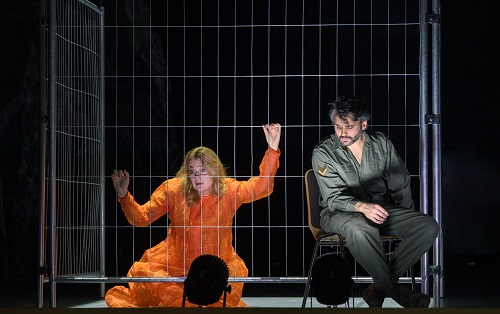Marc-Antoine Charpentier’s lyric tragedy Médée premiered in 1694 with its dedicatee, Louis XIV, in attendance. The five-act libretto adapted by Thomas Corneille from Euripides’ play retells one of the most lurid of Greek myths: the foreign sorceress Medea, torn between love for and revenge against her unfaithful husband Jason, eventually murders both her rival and her own children—then ascends into the heavens on a fiery chariot. Such a plot was well-suited to perform at the Théâtre du Palais-Royal, an imposing theater that accommodated over 2500 spectators and possessed state-of-the-art stage machinery.
Despite its establishment origins, Médée is in many ways an uncompromisingly subversive opera. Corneille and Charpentier refused to conclude their tragedy—as their immediate predecessors in the Sun King’s employ, Philippe Quinault and Jean-Baptiste Lully, typically did—with a bright, dance-like divertissement. Rather, the revelation of Médée’s murders is followed by an apocalypse in Corinth so savage that some read it as an ironic comment on Louis XIV wars of glory. Only the music itself offers some humane compassion.
Médée is the most substantial among Charpentier’s few operatic scores, containing over three hours of Italianate music, particularly notable for its pioneering recitatives, which change perspective and psychological affect quickly. Both the somber tone of moral self-examination and wide range of instrumental and vocal sonorities draw on Charpentier’s prior preeminence as a liturgical composer. Though the opera was a failure at its premiere—perhaps due to its political incorrectness in royal eyes—it is viewed today an example of the supreme heights that French grand opera reached in the Baroque period.
This new production at the Staatsoper Unter den Linden’s fall Baroque Festival assembles a star-studded team including stage director Peter Sellars, architect Frank Gehry, conductor Simon Rattle and soprano Magdalena Kožená.

Amidst these stars, the highlight of the production is the playing of the Freiburger Barockorchester. With Rattle pumping in his trademark level of energy and engagement from the podium, and the basso continuo tirelessly keeping up the momentum, I cannot recall—nor hardly imagine—a historically informed ensemble with more effortless virtuosity, timbral variety, interpretive nuance, and immediate response to interpretive direction. Act by act, they surmounted every challenge the score throws at them, as Charpentier grows more confident in what was at the time for him a new medium.
Vocally, this opera is all about the supernatural title character, around whom the others revolve. Kožená, a celebrated Czech mezzo, sang Médée seven years ago in Basel to great acclaim, and here she remains a commanding dramatic presence who imaginatively conveys the sorceress’s wide range of emotions. The voice penetrates particularly clearly in a rich upper middle range, while a slightly steelier top highlights the psychological strain she is under. Only phrases that dropped down into the bottom of the voice tend to fade out—hardly surprising, since Kožená’s voice sits between soprano and mezzo. At its best—but not always—her French is intelligible.
Even more vocally commanding is the experienced Italian bass Luca Tittolo as King Créon. A deep and warm voice, uniform from top to bottom, combined with immediately intelligible French, exemplify fine Baroque vocalism. Every scene in which he appeared seems to come alive, establishing an important, if ultimately dramatically futile, counterweight to Médée.
The remaining cast is comprised of mostly early music veterans and contains no weak links. Young but experienced Belgian tenor Reinoud Van Mechelen sings Jason with exemplary clarity and diction—using head-tones and a mixed voice to rise up when necessary into the counter-tenor range. The youthful freshness of English soprano Carolyn Sampson’s Créuse contrasts well with Médée’s deeper and more varied personality. Hungarian baritone Gyula Orendt, a house singer at the Staatsoper, effectively portrays Oronte’s impotent frustration. Native French is a clear advantage for soprano Jeanne Amzal, who projecting the words and music of Cléone and L’Amour with crisp clarity and strong feeling.

(c) Ruth Walz
In contrast to the subtlety and energy of the music, Gehry’s sets seem both static and indefinite. The stage, walled in back with metal, remains empty except for large translucent elements—to me, they resemble large trees or dinosaurs made of cotton candy. Most of the interest in the staging comes instead from the lighting by James Ingalls’, who works often with Sellars. Precise layers of color create surprising contrast and depth in the first three acts, but become murkier thereafter.
Yet, in the end, the dramatic success of the evening rests primarily with Sellar’s stage direction. As in most of his productions over the decades, characters appear as flesh-and-blood human beings struggling with moral dilemmas found in the modern everyday world. Sellars underscores this with modern colloquial supertitles: some find them invasive, but I find them refreshing and, in this case, remarkably true to the original French. Sellars has distinguished himself over the years, moreover, as one of the few modern opera directors with a truly subtle and sophisticated ear for music—directing as much off the score as the text.
That being said, Sellar’s weakness is the superabundance of brilliant ideas he generates. At times he struggles to contain them. Perhaps Médée is a critique of male chauvinism: from the Prologue on, Jason’s callous behavior with regard to the typical “first wife” (who got him where he is) is juxtaposed against the unquestioned warmth and comfort of female community. Perhaps Médée is about the “otherness” of immigrants: early on, Medea appears clad in an orange jump suit behind the chain link fence of an internment camp. Perhaps the opera is about Dionysian forces (today we call them psychological compulsions) that can undermine the stability and legitimacy of rational social order: spontaneous rounds of wild dancing often interrupt erupt ordered proceedings on stage. Perhaps it is all is about the human self-absorption and opportunism that divide us, especially among the powerful: characters in this production are constantly separated by boxes and fences.
All are valid in some sense—and all are timely messages. Given that Charpentier’s 325-year-old score may otherwise seem homogeneous to some ears, a manic cacophony of half-realized ideas is perhaps not the worst place to end up. Still, at times I feel this layering of interpretations blocks visceral engagement with the individual plights of Médée herself and those around her. Often the production is more affecting when it simply portrays actions unadorned.
Overall, the remaining four more performances of Médée here in Berlin offer a rare opportunity to see this masterpiece brought triumphantly back to life.
Andrew Moravcsik
Marc-Antoine Charpentier: Médée
Médée – Magdalena Kožená, Jason – Reinoud Van Mechelen, Créon – Luca Tittoto, Créuse – Carolyn Sampson, Cléone/L’Amour – Jehanne Amzal, Oronte – Gyula Orendt, Nérine/Bellone – Markéta Cukrová, Arcas/La Jalousie – Gonzalo Quinchahual, La Vengeance – Dionysios Avgeninos; Director – Peter Sellars, Conductor – Simon Rattle, Stage Design – Frank Gehry, Costume Design – Camille Assaf, Lighting Design – James Ignalls, Chorus Director – Dani Juris, Dramaturg – Antonio Cuenca Ruiz.
Staatsoper unter den Linden Berlin; 19th November 2023.
ABOVE: Magdalena Kožená (Médée) and Ensemble (c) Ruth Walz